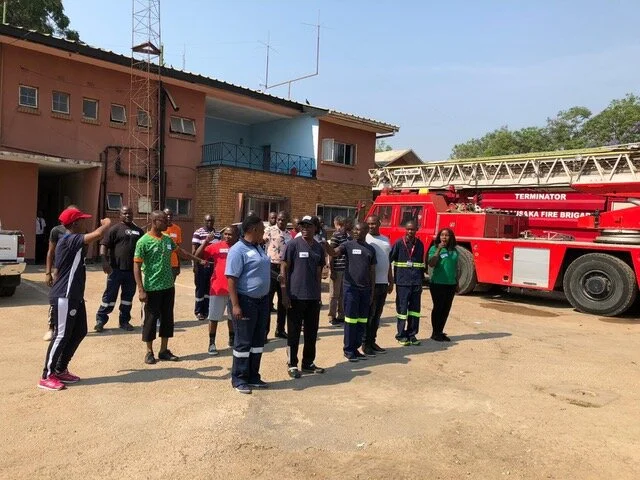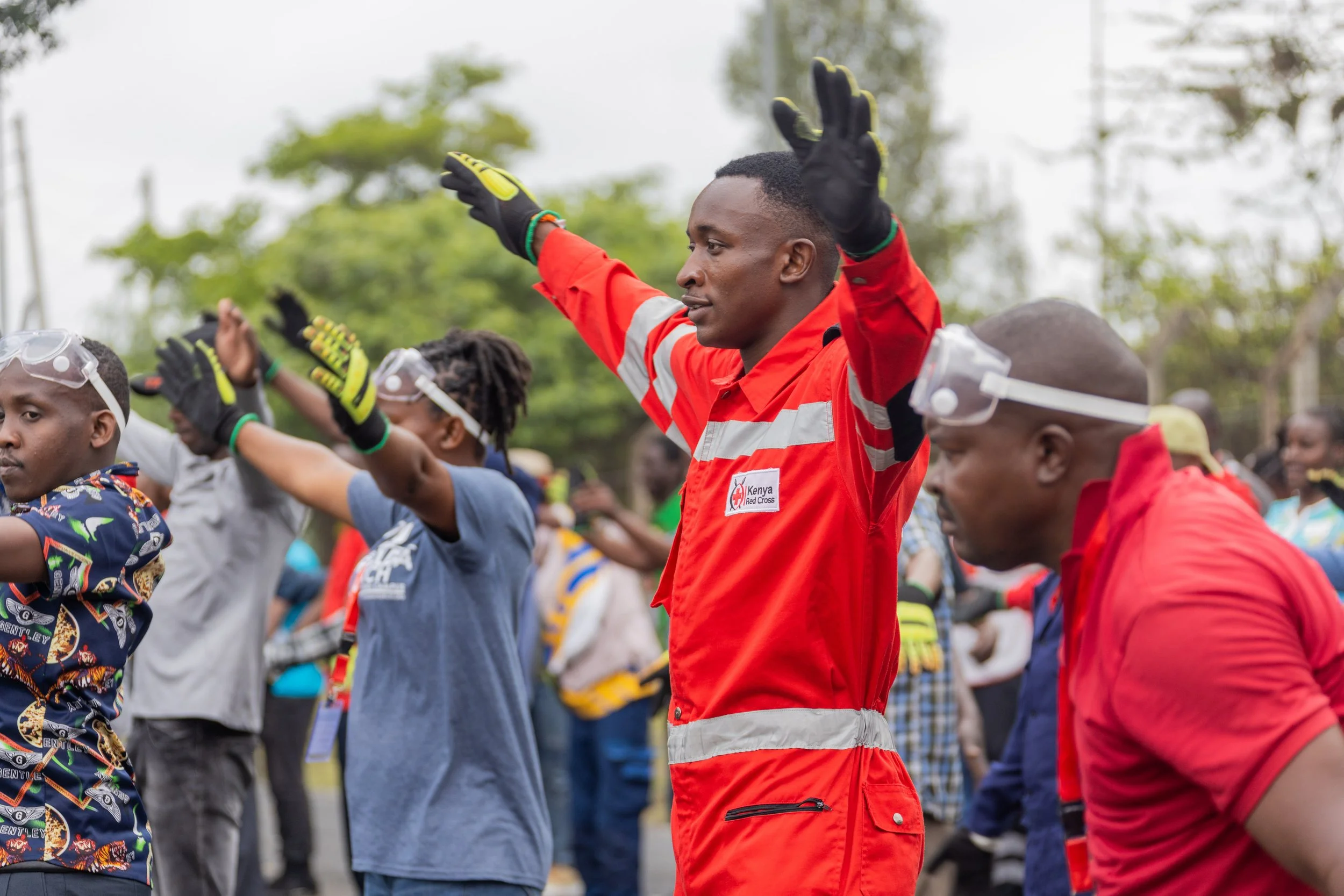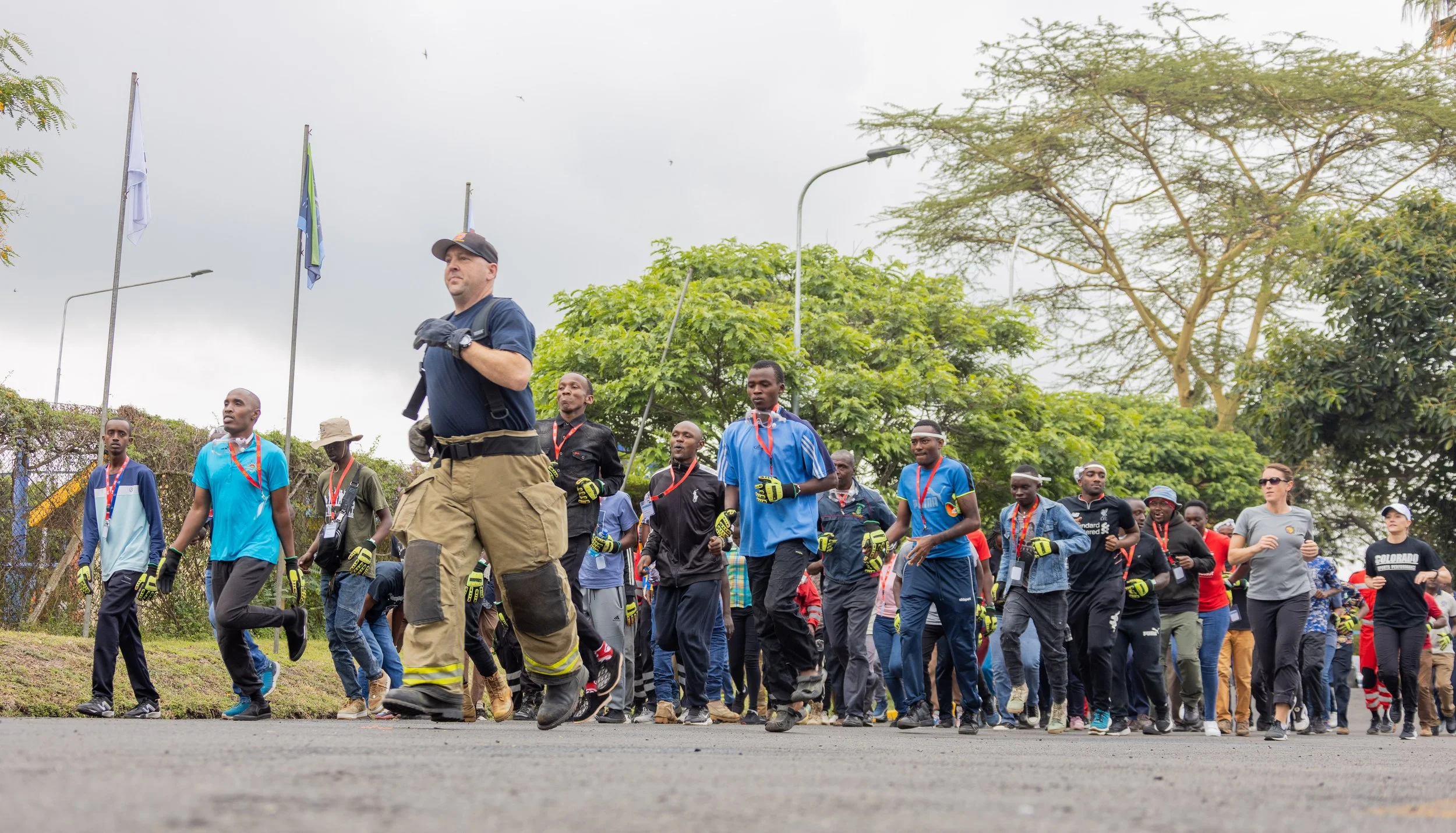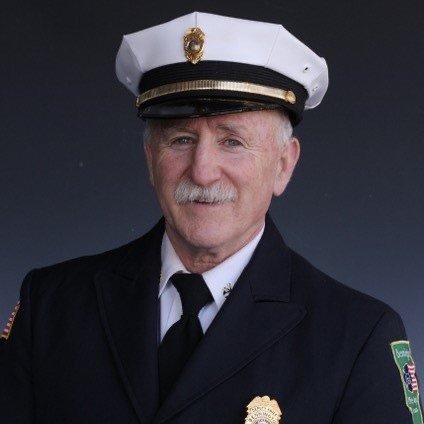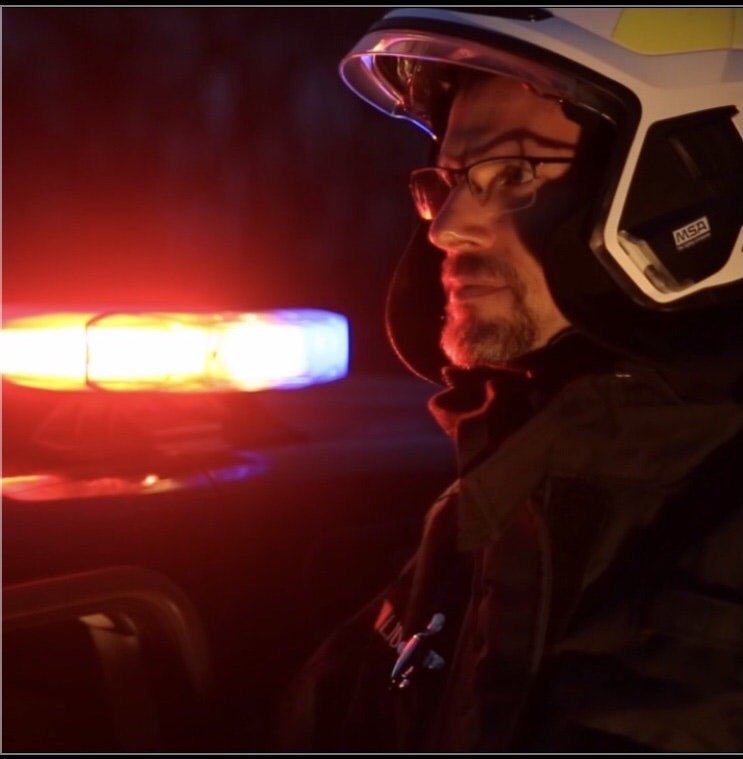We would like to recognize the different award winners from this year’s symposium to highlight the ever-growing fire service in Africa and the determination of first responders in Kenya and beyond.
Gas Cylinder Care
Gas cylinder care is a vital topic in communities that rely on these devices for cooking or other purposes. AFM’s staff team in Kenya, including Fire Safety Officer José Ngunjiri and Fire Safety Advocate Errol Sianga, regularly perform gas cylinder safety lessons in local communities. Now, you can access an official, professional recording of this training on our YouTube page! Whether you are a community member that relies on gas cylinders or you are a fire prevention instructor looking to further your understanding on the topic, please access the video below and watch the full lesson to help prevent deadly fires or explosions from gas cylinders.
Gas Cylinder Care Tips
Before using a gas cylinder, there are two steps you should always keep in mind:
Check the quality of your regulator. It needs to as clean as possible.
Take time connecting the regulator. Check to see if it is leaking or if there is any visible damage.
If a gas cylinder catches fire and starts to get out of control, remember to never throw your gas cylinder under any circumstances. If there is a fire that is starting to get out of control, take a solid, empty bucket and place it on top of the cylinder to create a vacuum, cutting off the air to the fire. Count slowly to five, then carefully remove the bucket away from you and turn off the cylinder. You can also drape a wet blanket and wrap the fire and cylinder completely. Again, count to five, then open it away from you and turn off the cylinder.
Kindly share this post and the video training with your communities to spread awareness on gas cylinder care.
Africa Fire Mission Receives Grant from Hamilton County ReSource
Africa Fire Mission is excited to announce we have received the Waste Reduction Innovation Grant from Hamilton County ReSource! This grant will provide financial support for our operations assisting AFM’s efforts in reducing firefighter PPE and supply waste, as well as using gently used firefighter PPE to support firefighters in Africa.
Firefighter Wellness
by Michael Anderson
Firefighter Wellness can be thought of as the firefighter encompassing their state of health including physical, mental, emotional and spiritual fitness. Firefighters should strive to improve their wellness and work to take steps in each of these areas to improve their lives and serve a very long career.
Fire service organizations have long been investing in the development of resources for fitness and items such as medical screenings. In recent years, more resources have been dedicated to behavioral health to highlight the needs of firefighters to address their mental and emotional fitness. This article will discuss a few of these topics and provide some small steps for individuals to work on their wellness.
Physical fitness:
Firefighting activities require a level of functional performance during response activities. Maintaining a level of fitness is necessary for firefighters and other emergency responders. The physical demands of firefighting along with the working environments require that members develop muscular strength and endurance. This functional fitness should include movements and activities that mimic situations that the firefighter will encounter in their duties.
Stretches, running, and other exercises are very important to a regular and beneficial fitness routine.
Maintaining a level of fitness through cardiovascular and strength training exercises has many benefits. Fitness activities will help firefighters develop muscular strength and endurance, allowing effective use of their equipment and more efficiency on incidents. Fitness helps with fatigue and recovery from strenuous work. The improved range of motion, strength, balance, and coordination also helps prevent injuries of firefighters. Additionally, fitness improves cardiovascular and respiratory system performance. Improvements in these areas both improve performance and overall health.
Medical Evaluations:
Routine medical evaluations are another component of firefighter wellness. Cardiovascular disease and occupational cancers continue to be leading causes of firefighter deaths in the United States. Several medical risk factors have been linked to line of duty death and injuries. The recently revised NFPA 1580 standards provide guidance on the areas to be evaluated during your medical exam.
The benefits of routine medical evaluations can be summed up in one word: detection. Early detection of medical conditions such as high blood pressure, high cholesterol, obesity, diabetes, and others will allow for treatment that can positively impact the risks of firefighters suffering a medical related emergency. Firefighters should take action when faced with increased risk factors from these medical conditions. Treatment for these conditions can reduce the impacts on a firefighter health event.
The increased risk of firefighters to cancer has been identified, recognized, and promoted throughout the fire service. Research has been able to link these increases risks to the exposures that firefighters face during their duties. Cancer screenings are encouraged to be included in your medical evaluation. Early detection and treatment have been shown to improve survival while allowing for reduced costs and less invasive procedures.
Behavioral Health:
The impact of the emotional stress that firefighters face is nothing new to those who serve. Many of us have seen our fellow firefighters experience emotional trauma with various impacts to their lives and careers. Suicides amongst first responders have been increasing at an alarming rate now that reporting mechanisms are in place. Research continues to show that ourselves and our colleagues are plagued by post-traumatic stress and the effects of self-coping activities that many choose to use to deal with these stresses.
A critical step in improving behavioral health is the understanding at the individual level and the organizational level that stress reactions to our job duties are normal. Developing a positive culture around the job stress and supporting members that need assistance can help ensure that mental and emotional fitness can be improved. As an organization, developing programs that look to support firefighters who are suffering from stress can be beneficial on the mental well-being of employees. Programs should look to ensure that members have access to specialized services that understand PTSD, firefighter stressors, alcohol and substance treatment, along with the ability to assist members with other areas of their lives that can impact their mental wellness.
Simple steps towards general wellness:
Maintain levels of functional fitness. Stay active, move often, and work to improve strength and endurance. Push yourself a few days a week and get your heart rate up towards your max heart rate.
Find fun activities with your exercise routine. Adding enjoyable activities to your routine will help you stay motivated in your fitness journey and will help your emotional fitness along the way.
Get an annual medical evaluation. Find a doctor or make an appointment with your physician. Tell them about the dangers firefighter face and ask them to include cancer screenings on a regular basis.
If your examination finds something, take action! Early detection leads to early intervention and vastly improves your ability to reduce your risks of injury or death.
Work hard to sleep well. Evaluate your sleep and find ways to sleep and rest better. Improved sleep can reduce stress and reduce risks.
Understand your stress and attack your stressors. Evaluate the stressors in your life and find ways to reduce how much they impact you. Managing your stress will make you a happier and healthier firefighter.
Find resources for your personal medical and mental health. Resources are available to help you overcome almost anything. Find some and use them when needed.
Physical wellness is key to improving your general wellness!
Taking small and simple steps can have big impacts on your personal and professional life. Begin the journey now and start becoming the best version of you.
Michael Anderson started in the fire service in 1998 as a volunteer in his rural hometown. He has served at Pflugerville Fire Dept. since 2000, currently holding the rank of Deputy Assistant Chief in Administration. With a passion for firefighter health and safety, Michael spent 14 years involved with the NFFF Everyone Goes Home Advocate Program. He has worked with firefighters and organizations across the United States working to improve the health and safety of firefighters. Chief Anderson also serves as an At-Large Director for the IAFC Safety, Health, and Survival Section.
Chief Anderson completed his undergraduate studies in Applied Arts and Sciences from Texas A&M University-Commerce and earned a master’s degree in Public Affairs from the University of Texas- Rio Grande Valley. Michael holds Fire Officer IV, Instructor III, Incident Safety Officer and Health & Safety Officer Certifications. In 2019, he Graduated the NFA Managing Officer program and achieved designation as a Chief Fire Officer from the CPSE Commission for Professional Credentialing in 2023.
Fireground Tactics
by F. R. Montes de Oca
Initial arrival at a fire often poses several simultaneous challenges for the officer to address rapidly. Utilizing the Rule of 3 can help the incident commander to develop a tactical posture. They are:
1. What do I have?
2. Where is it going?
3. What do I need?
The first question (What do I have?) addresses:
The terrain of an incident location or layout of a building can impact the tactics you should use.
What is the building used for? Living? Storage? Manufacturing?
Is it a single or multiple-family dwelling?
Are there victims? If so, how many? Are they exiting on their own?
What is the square footage and how many stories?
Are additional occupants still in the structure who need help to exit?
Similar questions can be asked for a vehicle fire: size (single, multi-vehicle or public transit vehicle. Victims out or entrapped?
The second question (Where is it going?) forces you to think about the possibility of spread:
Do I have exposures? Is high heat or high winds affecting fire spread?
Can I ignore the exposures and focus on the primary body of fire?
Will I need additional resources for fire progression AND exposures?
Must I focus all resources to rescue occupants?
Focusing on egress pathways for building occupants is imperative. Often-times with limited resources tactics must be focused solely on rescuing or assisting occupants exit the structure.
The third question (What do I need?) is based on what is discovered or decided upon by answering the first two questions. What resources needed implies deciding whether hoselines are applied directly initially or are supply lines needed – or must victim rescue be my first tactic?
The situation is often complicated by the fire rapidly spreading due to high winds or multiple victims needing rescue. When this occurs, tactics will change quickly from suppression to rescue.
While the tactics may address the initial and additional challenges, it is important to remain cognizant of additional aspects to ensure an effective fireground operation:
Communications, which is the critical conduit of incident management. All on-scene and responding members must be apprised of the current situation and have a clear understanding of their assignments.
Rehabbing responders operating on scene is one of the most important actions the Incident Commander can ensure occurs. Ensuring that members take a short break every 15 minutes or so will allow crew viability and increased scene effectiveness.
Incident Safety should be the overarching effort all scene commanders should undertake. Whether on scene at a structure fire, complex vehicular accident or hazardous materials incidents maintaining the safety and well-being of responders is imperative.
If formally assigned Safety Officers are not part of the department, it is advisable to appoint someone on scene whose only function is observing operations to ensure the safety and welfare of all firefighters. Whenever possible, the individual assigned the task should possess a mix of experience and formalized safety training.
At your next emergency incident pose the three questions to assist you in developing effective tactical decisions.
In closing, Incident command truisms that help officers maintain a sharper eye on effective tactical decision-making:
When a tactic is not working, change the tactic.
No matter how good your plan is, have a backup plan.
Frank Montes de Oca served as a firefighter/paramedic for over 38 years attaining positions as Chief of EMS, Training Bureau Commander, and Chief of Department. He remains engaged in managing and developing firefighter safety programs and mentoring leaders.
Firefighter Physical Fitness
by Howard Cohen
Firefighting is a dangerous and physically demanding job. Firefighters operate in harsh and challenging environments, use heavy, hard-to-handle tools, and wear many kilos of protective gear. We need to keep ourselves in great shape to do our jobs. This means we must care for ourselves through proper nutrition and hydration, physical exercise, and sufficient rest. This is what is minimally required to properly and safely perform our jobs.
If you stop and think about it, what is the one “tool” every firefighter uses at every call? It’s our body. We depend on our bodies for all aspects of firefighting. In this sense, firefighters are like elite athletes. While we may not have to jump, sprint, or throw a ball, we are often required to crawl, drag, or haul awkwardly shaped heavy objects in extreme heat conditions that greatly tax our cardiovascular systems. But there are important differences too. Elite athletes generally perform under optimal conditions. Firefighters respond to calls during the worst weather conditions. Elite athletes typically get a good night’s sleep before their big events. First responders are often woken up multiple times during the night. Elite athletes eat a well-balanced meal with regard to their upcoming sporting event. First responders' meals are often rushed, gobbled on the run, or interrupted by calls. However, the biggest difference is that it is all about winning or losing for elite athletes. What’s on the line for firefighters is often life or death; yours, your fellow firefighters, or a civilian’s.
The good news is that achieving a firefighter's operational level of physical fitness is not hard. However, it does require a commitment to exercise regularly. There are many great ways to hone your fitness level. If you can access YouTube, search for a type of workout that appeals to you. You will discover many free options to choose from. Ideally, your workouts will include strength training with weights or whatever heavy objects you have available to you and cardiovascular exercises, such as lunges, jumping jacks, running, climbing stairs, or any activity that gets your heart rate up. You don’t need a specific or fancy program to get in good workouts. All you need is to make a personal commitment to move your body and get your heart pumping. Any well-rounded program will benefit you in all aspects of fitness.
A good workout routine for first responders ideally includes four types of exercises.
1) Active movement exercises
2) Strength building
3) HiiT: High Intensity Interval Training
4) Deadlifts
Active movement: Exercises such as Bear Crawls, Mountain Climbers, or Spider Lunges engage nearly every muscle group and build core and cardiovascular strength and agility. Their primary purpose is to improve mobility.
Strength Building (Dumbbells): If you have them, dumbbells are preferable to barbells for first responder strength training because they allow for a greater range of motion and enhance overall muscle stabilization and activation. Dumbbells also help identify and eliminate strength imbalances by forcing the limbs to work unilaterally. If one side is significantly weaker than the other, there's no way to compensate. They are safer to use if you are working out alone. Finally, there is no limit to how you can use them in your workout.
HiiT: High-Intensity Interval Training: HiiT workouts consist of bursts of intense activity followed by short rest periods. They provide the most benefits in the least amount of time. The advantages of HiiT workouts include burning calories quickly, improving cardiovascular health, and enhancing metabolic function. Additionally, a HiiT workout increases muscle mass and effectively improves overall fitness levels.
Deadlifts: There is a tendency to think that deadlifts are just when you bend over and lift a heavy weight. In fact, there are many variations of the deadlift. They include squats, lunges, single leg deadlifts, suitcase squats and farmer walks. All are excellent exercises for building stronger Legs, core grip, and lower back strength.
There are no downsides to exercising and being physically fit. Physical fitness has been shown to prevent or treat various chronic health conditions resulting from unhealthy lifestyles, and it even counters certain aspects of the aging process. Studies indicate that regular exercise strengthens the heart and, when combined with a healthy diet, can reduce the risk of cancer and enhance the immune system. Being physically fit also helps lower the risk of injuries that can hinder your ability to work. Sometimes, firefighters overlook that physical fitness involves more than just working out; it also requires taking care of your body through proper nutrition, staying hydrated, getting enough sleep, and avoiding or limiting harmful substances like alcohol, recreational drugs, or tobacco.
The biggest obstacle to sticking with a fitness plan is boredom. Therefore, it is important for you to find or create a routine that holds your interest. Mix it up too. Don’t do the same workout day after day. Work out with a friend or your other brigade crew members. Make it fun. To the extent your schedule permits, making your fitness program a fixed and regular part of your daily routine is also helpful. Some people like to get their workouts in early in the morning. This way, no matter how the rest of the day unfolds, it’s a good day because you got your workout in. Other people like to work out at the end of the day. This way, they figure they have something to look forward to no matter what kind of day they are having. I get my workout in every morning after having two cups of black tea and reading the headlines in the paper. After my workout, I’m ready for whatever is coming my way.
In conclusion, this article aims to inspire you to find and commit to a personal fitness program that excites and motivates you. Honor your body—after all, it is the home of your holy soul. Now get moving and get your heart pumping!
If you want to learn more about fitness training for first responders, I recommend this article. If you would like to learn more about cancer prevention for firefighters, read this recent AFM blog post.
Howard A. Cohen was a volunteer firefighter for 20 years. He began his firefighting career as a chaplain and retired as the deputy chief. He is currently AFM’s online program content director. He frequently presents for the weekly virtual trainings and contributes to the AFM blog.
Cancer Prevention for Firefighters: A Vital Mission
Firefighters face unique and significant health risks due to their exposure to hazardous materials during their duties. Understanding these risks and implementing effective prevention strategies are crucial for promoting firefighter health and well-being.
Understanding Cancer Risks
Firefighters are regularly exposed to hazardous substances like benzene and formaldehyde, which can lead to serious health issues, including various cancers. The increased cancer risks make awareness and understanding essential for protecting firefighters' health.
Prevention Strategies
Employing effective prevention strategies can significantly reduce the cancer risks firefighters face during their careers. Key strategies include:
Use of Personal Protective Equipment (PPE): Wearing appropriate PPE is essential for minimizing exposure to harmful substances during firefighting. Regular maintenance of PPE ensures its effectiveness and keeps firefighters safe from hazards.
Health Monitoring Programs: Regular health screenings and monitoring programs can help detect early signs of cancer in firefighters, promoting timely intervention.
Training in Hazard Awareness: Providing training on hazard awareness helps firefighters recognize and mitigate risks associated with harmful exposures.
Wellness Practices
Promoting wellness practices among firefighters can enhance their overall health and well-being, mitigating health risks. Key wellness practices include:
Healthy Lifestyle Choices: Adopting a balanced diet, engaging in regular exercise, and getting adequate rest are essential for maintaining good health and a strong immune system.
Stress Management Techniques: Incorporating stress management techniques like mindfulness and relaxation can greatly benefit firefighters' mental well-being.
Regular Health Screenings: Early detection of potential health issues through regular screenings can significantly improve treatment outcomes.
No matter what your position in the emergency services is, it is important to keep your health in mind!
Conclusion
Firefighters face unique cancer risks due to exposure to hazardous materials. Awareness, effective prevention strategies, and wellness practices are key to reducing these risks and promoting firefighter health. By prioritizing these measures, we can ensure the safety and well-being of those who bravely protect our communities.
James Nyadwe is a Water Survival/Safety Expert and Trainer, Open Water Scuba Diver, and a Fire Advocate. James is passionate about sharing knowledge on safety issues on land and water that impact first responders. Additionally, James has served as an instructor for AFM’s virtual firefighter training.
Bush Fires
by Brad Fiore
Just like any other fire, there are two main strategies in fighting bush fires: Direct and indirect. Topography, fuel types, and resources may vary between the US and Africa, but the basic tactics are the same. In a direct attack, we remove either the oxygen or the heat, and in an indirect attack, we remove the fuel.
The best tool we have for fire extinguishment is water. Unfortunately, a lot of times, the fire is in an area that makes it difficult to get water to. Hand tools play a significant role in fighting bush fires. The basic types are cutting, digging, scraping, and smothering tools.
In a direct attack removing the oxygen is accomplished by smothering the fire. We can throw dirt on the burning material or pat small flames out with our tool. I’ve seen fire flappers used to beat the flames of large bushes. I am not familiar with how well this works, but from another point of view, in North America, our flappers are smaller, and we use them on small creeping fires. The technique is to drag the flapper over the burning material, maybe using a slight patting motion. Beating a fire uses a lot of energy in one concentrated area. It also seems that embers are kicked up into the air, which could start a spot fire. Other tools, such as hoes and fire rakes, can all be used to pat out small flames.
Smoke coming from trees can be a sign of a potential bush fire.
When you use water to remove the heat, use it sparingly and wisely. Always walk in line with the fire, spraying water along the fire edge. This will make your water work smarter. Any water that bounces will bounce into the flames ahead. If you stand perpendicular to the fire, the overspray and bounce will fall into the already burned area, wasting that water. It doesn’t take a lot of water to douse the flames, so attaching a low-volume nozzle to your hose will extend your water.
The indirect attack is more labor intensive, but provides a safer environment for the firefighters. The indirect attack is the process of cutting a fire line around the fire. You and your team will be cutting and scraping away the fuel so that when the fire reaches the fire line, there is nothing there to burn.
Tools for this are anything you can use to cut through the ground material and dig down to the soil. Hoes and rakes made for this are great, but a garden hoe that is sharpened will do the trick. That shovel we used before to throw dirt on the fire, hold it parallel to the ground, and you now have a scraping tool. Chainsaws work wonders, but a hand saw, and a pair of loppers will handle small bushes and brush. A hatchet or fire axe can help clear small trees.
Your goal is to get down to mineral soil, and the width of the line needs to be one and one-half the height of the fuels. If you are cutting in grass that is a foot and a half tall, you need to make a line that is 3 feet wide. Always start and end at an anchor point. A road, trail, open dirt area, or body of water. The best practice for cutting the line is to space your crew a few feet apart so that swinging tools do not hit a team member. Each member will take a swipe and move forward along the line. As the team moves, each member is clearing more along the line.
Once the line is cut, and if you have time, you can backburn. This intentionally burns the material between your fire line and the main fire. The main fire will be intense and may make its own weather, causing high winds. Lighting a fire ahead of this will make the fire small and manageable. It will grow as it gets closer to the main fire, but at this point, it is within your control lines.
Anytime you are fighting bush fires, always have escape routes planned and made known by all members fighting the fire.
From my experience teaching a couple of the virtual classes for AFM, I have come to find out that you, like most firefighters, are extremely inventive. With the knowledge all the instructors provide, you find ways to make the resources you do have work. That’s what firefighting is.
Be safe!
Brad Fiore is a volunteer firefighter of Cottekill Volunteer Fire Company and former Fire Chief. He also has experience as a 911 dispatch supervisor. Brad has served as an instructor for AFM’s virtual firefighter trainings.
Improving Your Leadership Success
by F. R. Montes de Oca
Leading a team can be frustrating and often stressful, but at the same time very rewarding. As a student of leadership, these are several leadership tips that I’ve learned over the years. These will help guide you on your leadership journey.
Demonstrate consistency in all you do. Be consistent in the way you handle challenges, successes, and failures. Those who work for you and with you depend on your measured, predictable demeanor. Before making a hasty decision, think of the outcome and consequences.
Be trustworthy. Personal trust is like a bank account. It may take you time to build trust with someone but lie or do something deceitful and their trust in you rapidly drops.
Leaders stay resilient during moments of hardship.
During the darkest moments, resiliency can help one to survive and thrive. As a leader, you will experience tragedy, failure, and disappointment. The need to be resilient is most critical during times of tragedy such as the loss of a department member or the after-effects of mass violence. If you choose to lead, a deep reservoir of resilience will help in your survival and success.
Practice humility. Successful leaders know when to show a little humility – especially when it allows the team to share in the limelight.
A little confidence goes a long way. Working in a profession that recruits and trains strong-willed men and women, leaders are surrounded by extremely self-confident team members. During operations when life-and-death decisions are necessary for one’s survival, confidence is often key to a positive outcome. However, there are times when confidence can be mistaken for arrogance. A fine balance of confidence and humility is always helpful… and respected.
Always practice honesty. Enjoy your accomplishments and leadership position. And within the role of your duties and interactions… be honest in all you do. In doing so, your influence builds other honest leaders.
Great leaders are great communicators. Practice communicating in your community!
Communicate every chance you get. The key to success as a leader is communicating to those who follow you and to those you follow. Make every effort to keep everyone on the same page so your team operates as a solid unit.
The moral of this story? 1) Learn from everyone. 2) Lead with your head and your heart. 3) Never demand more than you are willing to give.
Frank Montes de Oca served as a firefighter/paramedic for over 38 years attaining positions as Chief of EMS, Training Bureau Commander, and Chief of Department. He remains engaged in managing and developing firefighter safety programs and mentoring leaders.

